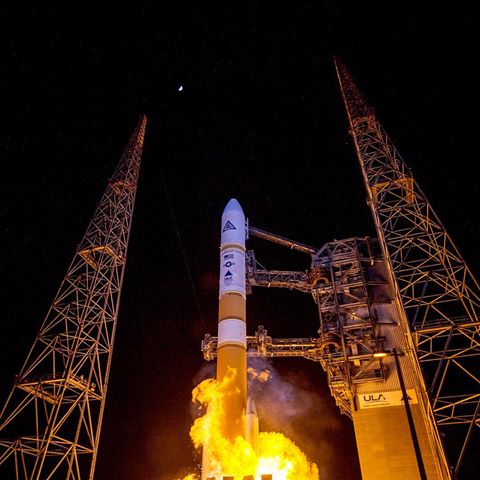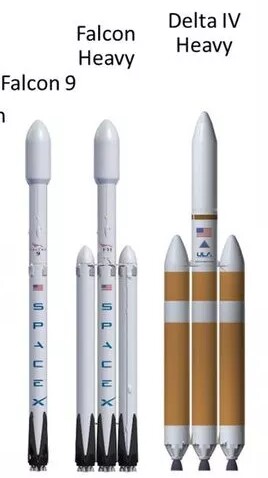Discussion
MartG said:
Just to add some data on density...
Liquid Hydrogen - 70kg/cubic metre
Liquid Methane - 422 kg/cubic metre
RP-1 - 810 kg/cubic metre
Not sure what the ratio of each of them needed for combustion is i.e. how many cu.m of each per cu.m of LOX
Rocket engines are always done on mass ratios:Liquid Hydrogen - 70kg/cubic metre
Liquid Methane - 422 kg/cubic metre
RP-1 - 810 kg/cubic metre
Not sure what the ratio of each of them needed for combustion is i.e. how many cu.m of each per cu.m of LOX
H2/LOx 1:4.13
CH4/LOx 1:3.21
RP1/LOx 1:2.58
Source: https://en.wikipedia.org/wiki/Liquid_rocket_propel...
Hydrogen / Oxygen rockets like to run fuel rich. They're more efficient that way thanks to that huge "afterburner" they create, plus it's easier to engineer. The closely-related Atlas 4 and Space Shuttle/SLS main engines run at a 6:1 oxygen to fuel ratio.
That characteristic big fireball at launch on hydrogen powered rockets like the Delta 4 is one of the reasons why they're hard to get man rated.

And we all know how hard that is anyway. Unless it's a NASA rocket of course.
That characteristic big fireball at launch on hydrogen powered rockets like the Delta 4 is one of the reasons why they're hard to get man rated.

And we all know how hard that is anyway. Unless it's a NASA rocket of course.
During the Shuttle era there were a few occasions when, after a pad abort, a huge and almost invisible hydrogen fire surrounded the Orbiter.
John Young once said that they couldn't really use the emergency escape/slip-wire system in circumstances like this due to the fact that the astronaut might get a bit "crispy" if they ventured outside.
Typical Young understatement.
John Young once said that they couldn't really use the emergency escape/slip-wire system in circumstances like this due to the fact that the astronaut might get a bit "crispy" if they ventured outside.
Typical Young understatement.
Beati Dogu said:
He was a remarkable men. The right stuff indeed.
I love how he was told the Shuttle program had been funded while he was bouncing around on the surface of the moon.
He'd go on to command the first & ninth Shuttle flights of course.
And the 9th almost ended in disaster. They were lucky to make it back.I love how he was told the Shuttle program had been funded while he was bouncing around on the surface of the moon.
He'd go on to command the first & ninth Shuttle flights of course.
Eric Mc said:
During the Shuttle era there were a few occasions when, after a pad abort, a huge and almost invisible hydrogen fire surrounded the Orbiter.
John Young once said that they couldn't really use the emergency escape/slip-wire system in circumstances like this due to the fact that the astronaut might get a bit "crispy" if they ventured outside.
Typical Young understatement.
Aye indeed.John Young once said that they couldn't really use the emergency escape/slip-wire system in circumstances like this due to the fact that the astronaut might get a bit "crispy" if they ventured outside.
Typical Young understatement.
Just goes to show how modern society has regressed in general [no one here btw I'm not having a dig at anyone]. Getting lobbed into orbit, sitting on top of a barely contained bomb is never going to be routine.
It is what it is. You have to accept it or stay on the surface.
Eric Mc said:
MartG said:
Looking at the relative sizes of D4H and the Lox/RP1 fuelled Falcon Heavy...

...it is apparent the Delta is the same height but a lot 'fatter' yet carries less than half the payload - 28,790kg to LEO compared to FH's 63,800
Thanks.
...it is apparent the Delta is the same height but a lot 'fatter' yet carries less than half the payload - 28,790kg to LEO compared to FH's 63,800
That's what I was getting at. The decision to use LOX/H for all the stages shows that there is a performance shortfall.
The USAF/NRO have requirements for payloads to GTO and GEO. Going direct to GEO is a very difficult mission and in fact most rockets can send more payload to Mars than direct to GEO, this is why most satellites go to GTO and then use their own rocket engine to circularise.
The Delta IV heavy can send 6500kg to GEO which is actually more than the Falcon Heavy can do reusing the boosters. A fully expendable Falcon Heavy can do 8500kg, a Falcon Heavy reusing the booster and expending the centre core can probably do around 6500kg.
Obviously reusable Falcon Heavy can put 28,000kg in LEO so you could fly a nearly fully fueled Centaur upper stage and a 6500kg satellite and have them fly to GEO or beyond
The first qualification model of the P120C solid-fuel motor, configured for Vega-C, was static fired yesterday on the test stand at Europe’s Spaceport in French Guiana.
Article here http://www.esa.int/Our_Activities/Space_Transporta...
Article here http://www.esa.int/Our_Activities/Space_Transporta...
AshVX220 said:
I am surprised that the established rocket builders aren't following SpaceX's lead and designing recoverable rockets, instead they seem to be continuing down the same path, eventually their launch systems will just be too expensive and they'll lose out to the cheaper companies like SpaxeX and eventually Blue Origin.
The issue is lack of vision and risk aversion.Reusability has always "failed" the economic test which is that the development costs predicted for any given reusable system always vastly exceed any savings when spread over a limited number of flights.
The analogy about how expensive flying would be if you threw the planes away can be reversed. Imagine how expensive achieving 10 flights would be if you had to demonstrate that the plane would last 10,000.
Where Musk has really been smart is that he has hidden his reusability development campaign inside a NASA programme ( COTS, and NASA were okay with it). Recovering an expendable rocket that someone else has paid for a much cheaper than all the upfront engineering to design something that you fly and (try to avoid) crash on your own money.
The issue is that if ESA and NASA wanted to do a reusable space programme they have to get one funded and deliver on what they promised. The same goes with the major defence contractors, their horizon is to do something and get paid not to increment along the way to Mars.
I should also add that the reusability on the Falcon 9 probably hasn't paid back yet and probably won't until they start deploying StarLink.
Article - "ESA safeguards Europe’s guaranteed access to space through its Future Launchers Preparatory Programme, FLPP. "
http://www.esa.int/Our_Activities/Space_Transporta...
http://www.esa.int/Our_Activities/Space_Transporta...
The upper stage of an Ariane 4 launched over 20 years ago has broken up in orbit
https://sputniknews.com/world/201908151076555263-u...
I wonder what could have caused it to go pop after so long - I'd assume anything holding pressure would have been vented long ago
https://sputniknews.com/world/201908151076555263-u...
I wonder what could have caused it to go pop after so long - I'd assume anything holding pressure would have been vented long ago
Eric Mc said:
Beati Dogu said:
Probably not, unless they used it for thrusters or engine starts. Third stages like his were powered by liquid hydrogen & oxygen.
It was attitude control thrusters I was thinking of rather than the main rocket motor. The Vega is a solid fueled rocket, isn't it.Gassing Station | Science! | Top of Page | What's New | My Stuff



